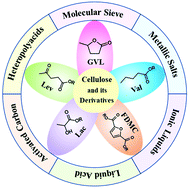Recent advances in the chemical valorization of cellulose and its derivatives into ester compounds
Abstract
Cellulose is the most abundant, renewable carbohydrate resource in nature, providing human society with a broad spread of materials for production and living. Compared with the mature textile and paper industries, technologies for cellulose utilization to produce energy and chemicals are still under development. In particular, the depolymerization of cellulose to glucose and further transformation into various fuel compounds or chemicals has received considerable attention as a sustainable approach to address the energy crisis and environmental issues raised by massive fossil consumption. Among various cellulose derived molecule types, ester is one of the most appealing owing to its unique physicochemical properties, reactivities and functions. This review summarizes recent advances in the chemical synthesis of esters from cellulose and its derivatives. Various esters, including alkyl levulinates, γ-valerolactone, valerates, pentenoates, lactates etc., have been effectively prepared from cellulose feedstock or its downstream platform compounds. The catalytic systems were highlighted with rational integration of the active sites for the tandem reactions involved in the conversions. The kinetics, process integration, selectivity control and catalysis mechanism were also discussed in detail. Finally, an outlook of the future direction, as well as the challenges, for cellulose ester production were also illustrated.

- This article is part of the themed collection: Green Chemistry Reviews


 Please wait while we load your content...
Please wait while we load your content...